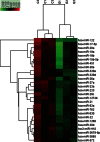Plasma miR-17-5p, miR-20a and miR-22 are down-regulated in women with endometriosis
- PMID: 23203215
- PMCID: PMC3733164
- DOI: 10.1093/humrep/des413
Plasma miR-17-5p, miR-20a and miR-22 are down-regulated in women with endometriosis
Abstract
Study question: Can plasma microRNAs be used as a non-invasive diagnostic test for the detection of endometriosis?
Summary answer: Plasma miR-17-5p, miR-20a and miR-22 are down-regulated in women with endometriosis compared with those without endometriosis in mainland China.
What is known already: There is currently a pressing need to develop a non-invasive diagnostic test for endometriosis. Altered circulating microRNA profiles have already been linked to various disease states.
Study design, size, and duration: This was a prospective laboratory study in a tertiary-referral university hospital in Beijing, PR China, between January 2012 and May 2012. Twenty-three women with histologically proven endometriosis and 23 endometriosis-free controls were enrolled in this study.
Participants/materials, setting, and methods: Laparoscopic inspection of the abdominopelvic cavity was performed for each patient, and peripheral blood samples were collected before laparoscopy. Microarray-based microRNA expression profiling was used to identify differentially expressed microRNAs in plasma samples between women with and without endometriosis, and quantification of selected microRNAs was performed using quantitative RT-PCR.
Main results and the role of chance: Twenty-seven microRNAs were differentially expressed between women with and without endometriosis, of which six microRNAs (miR-15b-5p, miR-17-5p, miR-20a, miR-21, miR-22 and miR-26a) were selected for validation. MiR-17-5p, miR-20a and miR-22 were significantly down-regulated in women with endometriosis compared with controls (P = 0.011, 0.0020 and 0.0002, respectively), yielding an area under the receiver operator characteristics curve of 0.74 [95% confidence interval (CI): 0.58-0.90], 0.79 (95% CI: 0.65-0.93) and 0.85 (95% CI: 0.71-0.98) in discriminating endometriosis from controls, respectively.
Limitations and reasons for caution: Our sample size was small and all cases were rAFS stage III-IV, which may limit generalization of plasma microRNAs for early diagnosis of endometriosis. Moreover, only six microRNAs were selected for validation.
Wider implications of the findings: Plasma microRNAs provide a promising opportunity for detection of endometriosis.
Figures



References
-
- Ambros V. The functions of animal microRNAs. Nature. 2004;431:350–355. doi:10.1038/nature02871. - DOI - PubMed
-
- Becker CM, Rohwer N, Funakoshi T, Cramer T, Bernhardt W, Birsner A, Folkman J, D'Amato RJ. 2-methoxyestradiol inhibits hypoxia-inducible factor-1{alpha} and suppresses growth of lesions in a mouse model of endometriosis. Am J Pathol. 2008;172:534–544. doi:10.2353/ajpath.2008.061244. - DOI - PMC - PubMed
-
- Burney RO, Hamilton AE, Aghajanova L, Vo KC, Nezhat CN, Lessey BA, Giudice LC. MicroRNA expression profiling of eutopic secretory endometrium in women with versus without endometriosis. Mol Hum Reprod. 2009;15:625–631. doi:10.1093/molehr/gap068. - DOI - PMC - PubMed
-
- Chen X, Ba Y, Ma L, Cai X, Yin Y, Wang K, Guo J, Zhang Y, Chen J, Guo X, et al. Characterization of microRNAs in serum: a novel class of biomarkers for diagnosis of cancer and other diseases. Cell Res. 2008;18:997–1006. doi:10.1038/cr.2008.282. - DOI - PubMed
-
- Cho S, Choi YS, Yim SY, Yang HI, Jeon YE, Lee KE, Kim H, Seo SK, Lee BS. Urinary vitamin D-binding protein is elevated in patients with endometriosis. Hum Reprod. 2012;27:515–522. doi:10.1093/humrep/der345. - DOI - PubMed
Publication types
MeSH terms
Substances
Grants and funding
LinkOut - more resources
Full Text Sources
Other Literature Sources
Medical
Research Materials

